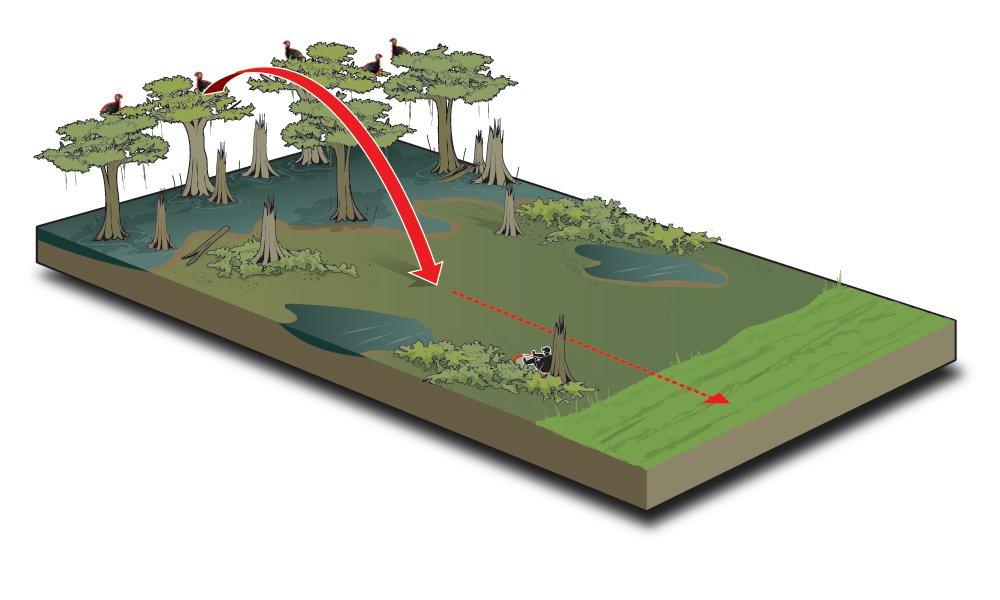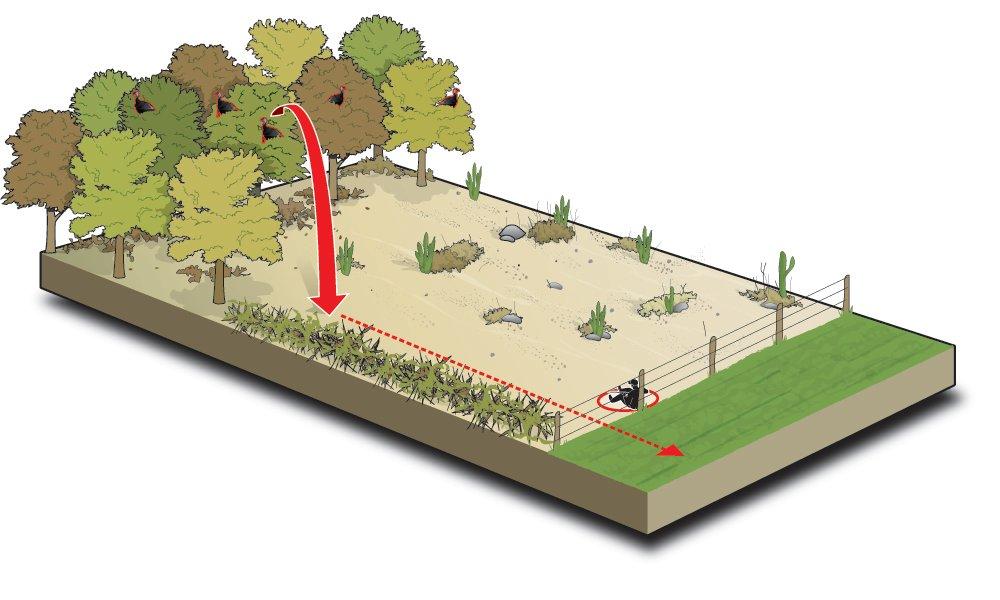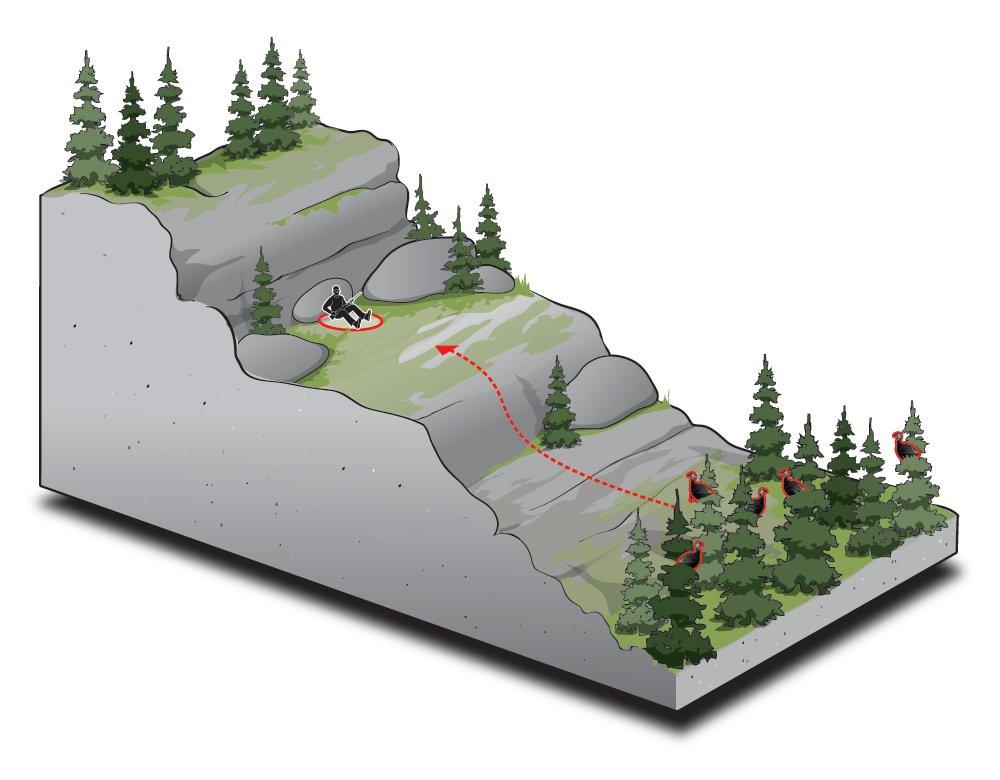Get Close, Don't Move, Wait for Fly-Down . . .
Throw out that rule that says setting up over a football field away on a roosted gobbler is the way to go. The trick to toppling many tough longbeards is to sneak in early and set up close, well before sunrise. Sometimes you have to toss out timeworn tradition to legally take dogwood-time gobblers.
50-Yard Setup
Quaker Boy's late-great Wayne Gendron possessed the casual confidence many veteran turkey hunters do, and a kind of radar-like ability to setup inside the gobbler's safety zone. Once, on a Missouri hunt, we eased toward a roosted longbeard, when suddenly the sound of wingbeats told us we'd bumped some pre-dawn turkeys.
Jakes, Wayne whispered dismissively as the young gobblers winged off in the other direction. But as our footsteps padded up a rise, the longbeard sounded off, just over the knob, still on a limb.
There he is, Gendron softly said. We'd both instinctively crouched at the gobble. The turkey was 50 yards away, if that.
Wayne stayed put and retrieved his timeworn box call. I crawled toward a skinny oak that would put me on a hilly spine where I hoped the tom would come. The bird gobbled again. Dawn arrived. Hidden by the rise, I scratched some leaves to sound like an approaching hen, and the gobbler about choked. Wayne remained quiet as the nearby bird gobbled repeatedly.
We waited, heard wingbeats, and the unseen turkey landed in front of us. Wayne then followed with soft yelping, and the gobbler barked back over and over. We heard footsteps, and watched the gobbler ease into view on the far edge of shotgun range and straight off my barrel. That's when things got fun.
The gobbler popped into strut, and hung up there in the woods, a gorgeous thing to see. Many more minutes later, though, he began to test our patience. Maybe the longbeard felt the same way, as it drifted off down the hill, then gobbled, gobbled again, and faded fast.
Gendron, who had stopped calling once the tom had appeared, listened to and watched all this. As the bird eased off, he hit him again with soft clucks and yelps.
Back the gobbler came as if Wayne had just cast bait and solidly hooked the tough tom by the beak. I dropped the tom when that big snowball head periscoped up one last time.
On other hunts I'd seen Wayne do the same thing: set us up tight in the dark, call softly after the gobblers flew down, stay patient, and kill birds. Wayne's gone now, missed by many, but I'll always smile about his steady, sensible approach to hunting spring longbeards inside their safety zones.
Setup Smarts
When gobblers are roosting with hens, turkey veteran Gary Sefton emphasizes, I want to get in close in the dark and hope some of the hens fly down in my direction. If I'm real lucky they'll go over me and I'll be between them and the gobbler, which is where you always want to be.
As all turkey hunters know, it may not work one time, but hang with that approach, and the possibility increases. If you have nailed the exact location of turkeys the afternoon before, you can approach that roost under the cover of night, well before sunrise. You can be there when they wake up. Once you're in tight, other tactics come into play.
- Alternative Locator Calls. Think outside the barred owl and crow locator drill. Turkey guru Ray Eye often softly hoots like a great horned owl (not the typical barred owl approach) with his natural voice to locate tight turkeys on the edges of the day, both before hunting them, and in the morning to confirm location. To do this, practice making the hoo-hoohoo-hoo-hoo call, then use it.
- Early Risings Rule. After roosting a gobbler, hunt that bird seriously. Yeah, spring turkey camp is plenty of fun, but pace yourself with socializing until after you tag your bird. Get up an hour earlier than you typically would, and quietly establish your setup in the dark.
- Silent Setups. When sharing hunts with buddies, there's a tendency to talk too much. Two words: shut up. Slip silently into your setup position in the dark. If you must talk, whisper.
- Call Choices. Hands-free diaphragm calls are the best choice for in-tight setups where the turkeys might see the hand movement required for friction calls.
- Flush 'Em Out. Are your turkeys regrouping after fly-down and not coming in? Are they hanging close, but still out of range? Consider the fall hunting technique of flushing flocks. When you separate hens from the dominant gobbler, the action can be fast and furious as that lonely longbeard seeks out scattered hens.
Close the Deal
Extreme roost setups are options in your game plan. But you have to know when to be cautious and when to force the issue.
I once scouted a New Hampshire spring gobbler before the season on a farm that routinely saw some in-season hunter traffic. Not only would killing the bird prove challenging, but I'd have to consider opening-day influences. So, I did a number of obsessive-compulsive things all of us die-hards favor.
I roosted the turkey on a regular basis in the weeks before the opener. Sometimes he favored one side of the river; sometimes mine on the farm. The late afternoon before the opener I fortunately located the tom on my side, so I sat down in the woods and waited for him to fly up. At one point, another scouting hunter walked right past me, obviously late for something by the way he was moving. That worried me a little, but I'd just have to play my hand.
The next morning I parked my truck well before dawn and walked the half-mile to the bird. I found the tree I'd picked the day before and slinked down, mouth call tucked in my cheek.
The bird first gobbled on the roost — on a limb but well under 100 yards. I stayed quiet, though far off some guy romanced his barred-owl hooter.
Big wings ticked branches on the way to the ground. Once there, the turkey gobbled some more. That's when I first called. He ripped back on the edge of range — unseen through ground cover.
Ready, my shotgun had affixed itself to my bent left knee well before that, and I held the assumed shooting position, mentally willing the bird into range.
Problem is, the turkey hung up. At that, I called, eager to close the deal. He'd have no part of it. Were other hunters listening to my tom foolery? Were they moving in on the vocal gobbler? Such are the thoughts of a turkey-obsessed hunter.
So I shut up. So did the bird, fortunately. I waited a long, long time, feeling the gobbler was in no hurry. Clearly another approach was needed to unhinge the bird. My response? I spit the mouth diaphragm out.
Say what? Yawp-yawp-yawp, I softly called with my natural voice. GRROBBLE came the response after the many long minutes of shared silence. The tom was right there, right now, well inside range. He'd waited all that time. A minute later, he was flopping at my feet.
Go here for more Realtree turkey hunting. Follow us on Facebook.
Editor's note: This Realtree.com evergreen article was first published March 31, 2011.











